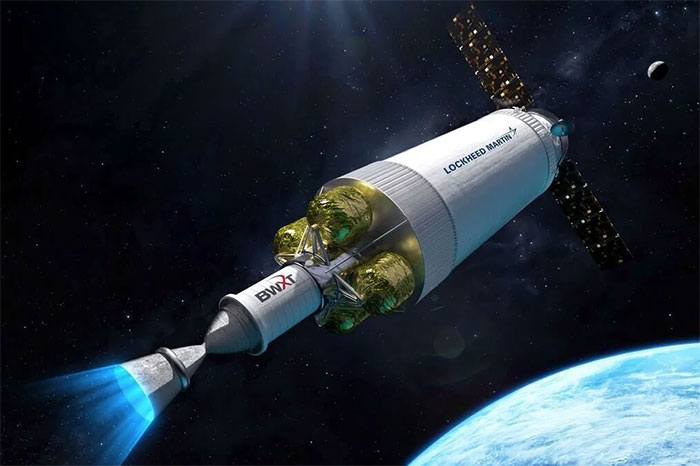America is about to launch a spacecraft with the most advanced technology in the world
Nowadays, the race to explore and conquer space in the context of a technological explosion has urged Western countries to build launch vehicles using nuclear propulsion.
On July 26, 2023, the US announced plans to launch the world's first nuclear-powered spacecraft into Earth orbit in 2027.
Specifically, under a contract issued by NASA and the Defense Advanced Research Projects Agency (DARPA) , the US Department of Defense unit is seeking to develop a nuclear-thermal rocket engine - a key technology long coveted by both NASA and the Pentagon, which could significantly speed up space travel and help humans reach Mars quickly, the Washington Post reported.
During a press conference on July 26, NASA and DARPA also announced that they had reached an agreement with the largest US defense contractor, Lockheed Martin, to design, build and test a prototype of this nuclear-thermal rocket engine. If Lockheed Martin meets all the milestones, including the test flight, the company will receive nearly $500 million, half from NASA and half from DARPA.
New Era of America and Humanity
"We believe we will open a new era for America and for humanity, becoming a 'powerful arm' supporting humanity's missions of exploring the Moon as well as deep space exploration" - Kirk Shireman, Vice President of Lockheed Martin believes.
Under the contract, defense giant Lockheed Martin will both develop and demonstrate the spacecraft in a project called Demonstrator Rocket for Agile Cislunar Operations (DRACO) . Lockheed Martin says the nuclear-powered propulsion technology means the thrusters are two to five times more powerful and efficient than conventional rocket engines; and will of course allow the spacecraft/rocket to travel faster and farther.

Illustration of a Lockheed Martin spacecraft using a nuclear-powered rocket engine to fly into Earth orbit. (Source: Lockheed Martin).
Lockheed Martin says its nuclear thermal propulsion technology would use a fission reactor to rapidly heat hydrogen propellant to very high temperatures, then send that gas through an engine nozzle to generate powerful thrust.
DRACO's fission reactor would work by splitting low-enriched uranium atoms inside a nuclear reactor - a process that would convert frozen hydrogen (-251 degrees Celsius) into extremely hot compressed gas (2,427 degrees Celsius) inside the engine - which would propel the spacecraft straight forward.
This reactor will be built by Lockheed Martin's partner, nuclear fuel supplier BWX Technologies (USA), in Lynchburg, Virginia, USA.
Once the spacecraft is fitted with Lockheed Martin's rocket engines, it will be launched into a high orbit between 700 and 2,000 kilometers above Earth. The spacecraft could remain in orbit for about 300 years — long enough for its dangerous radioactive fuel to decay to safe levels, Livescience reported.

This reactor will be built by BWX Technologies (USA) in Lynchburg, Virginia, USA.
Nuclear propulsion is a key capability in NASA's path to sending astronauts to Mars, NASA says. A nuclear-powered rocket would make trips to the Red Planet faster, make missions less complicated, and be safer for crews. It would require significantly less propellant than chemical rockets, allowing future space missions to carry more science payloads. It could also help NASA return astronauts to the Moon and establish a long-term presence there.
The Pentagon is also interested in more efficient fuel sources for space travel, especially as it seeks to build satellites that can maneuver in space, making them harder for adversaries to target. DARPA says the technology would help move 'larger payloads to more distant locations in cislunar space—the space between Earth and the Moon.' Doing so would require a leap in propulsion technology. The Pentagon is waiting for Lockheed Martin to make that breakthrough, the Washington Post reports.
- America is about to launch the most advanced ship on Mars
- India continues to delay the launch of the RLV-TD spacecraft due to technical problems
- The US Air Force is about to launch a secret spacecraft
- The UAE is about to launch a spacecraft to Mars
- America prepares to launch the second shuttle
- Russia revealed the time to launch the 'extreme' spacecraft to the Moon
- China will launch the first cargo spacecraft in April
- America spent a billion dollars to get cosmic dust
- America uses trees to ... spy
- India launched unmanned ships onto Mars in 2013
- China is about to launch unmanned spacecraft
- China rises high in science and technology sky
 Van Allen's belt and evidence that the Apollo 11 mission to the Moon was myth
Van Allen's belt and evidence that the Apollo 11 mission to the Moon was myth The levels of civilization in the universe (Kardashev scale)
The levels of civilization in the universe (Kardashev scale) Today Mars, the sun and the Earth are aligned
Today Mars, the sun and the Earth are aligned The Amazon owner announced a secret plan to build a space base for thousands of people
The Amazon owner announced a secret plan to build a space base for thousands of people